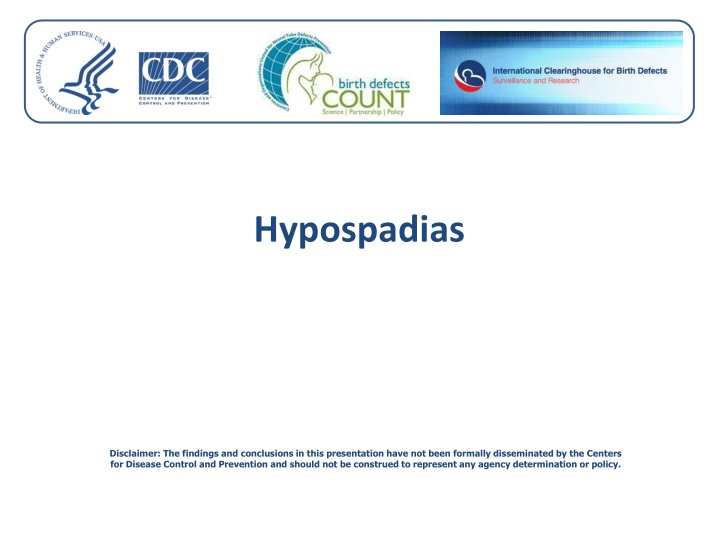
Clinical Features of Hypospadias
Hypospadias is a congenital anomaly affecting male external genitalia, resulting in the urethral meatus opening on the underside of the penis. This condition can lead to penile curvature known as chordee. Learn about the main features, embryology, associated anomalies, and clinical subtypes of hypospadias, including tips for coding and reporting. Severe subtypes may present with ambiguous genitalia. Understanding these clinical features is crucial for accurate diagnosis and management.
Download Presentation

Please find below an Image/Link to download the presentation.
The content on the website is provided AS IS for your information and personal use only. It may not be sold, licensed, or shared on other websites without obtaining consent from the author. If you encounter any issues during the download, it is possible that the publisher has removed the file from their server.
You are allowed to download the files provided on this website for personal or commercial use, subject to the condition that they are used lawfully. All files are the property of their respective owners.
The content on the website is provided AS IS for your information and personal use only. It may not be sold, licensed, or shared on other websites without obtaining consent from the author.
E N D
Presentation Transcript
Hypospadias Disclaimer: The findings and conclusions in this presentation have not been formally disseminated by the Centers for Disease Control and Prevention and should not be construed to represent any agency determination or policy.
Learning Objectives By the end of this presentation, participants will be able to Describe the clinical features of hypospadias Understand the main epidemiological features of hypospadias Apply tips for coding and reporting Improve knowledge and practice of hypospadias surveillance Hypospadias | 2
Hypospadias: Definition Hypospadias is a common congenital anomaly of the male external genitalia, in which the urethral meatus (opening of the urethra) opens in the ventral side (underside) of the penis. The shortening of the ventral side of the penis found in hypospadias can result in a penile curvature, known as chordee. Hypospadias | 3
Clinical Subtypes Hypospadias is commonly classified into one of three categories, according to the location of the urethral meatus in relation to the tip of the glans of the penis. Note: All of these openings are not present in one single newborn. Typically, there will only be ONE opening. Hypospadias | 4
Main Features Feature Typical findings Embryology Development of male external genitalia is influenced by androgens secreted by fetal testes. The penile urethra is formed at the end of third month, while the most distal portion of the urethra is formed during the fourth month. Hypospadias is the result of failure of urethral folds to completely fuse. Associated anomalies Cryptorchidism and inguinal hernia are the most common. Occasionally associated with vesicoureteral reflux. May be part of recognized syndromes Hypospadias | 5
Clinical Features Males with hypospadias typically have a redundancy of the prepuce on the dorsal side of penis and a deficiency on the ventral side. Severe subtypes are often accompanied by chordee: ventral (downward) curve of the penis, which may result from cutaneous or fibrous restriction. Chordee may occur without hypospadias. Redundancy Chordee Deficiency Distal penile hypospadias Hypospadias | 6
Additional Clinical Features Severe subtypes (penoscrotal, scrotal and perineal) may appear as ambiguous genitalia. Hypospadias with separation of the scrotal sacs and absence of palpable testes bilaterally in a term infant should prompt an evaluation for ambiguous genitalia. The differential diagnosis is based on detailed clinical workup Ambiguous genitalia in a 46XX female with virilizing adrenal hyperplasia. The clitoris is enlarged, resembling a short penis with hypospadias, and the labia are rugated, resembling the scrotum. Penoscrotal hypospadias Photo courtesy of http://www.pediatricurologybook.com/hypospadias.html Hypospadias | 7
Diagnosis Hypospadias is usually easily recognized on physical examination at delivery or on autopsy. However, without a careful examination of the penis, less severe cases may be missed. Prenatal diagnoses must be confirmed postnatally. While the most severe cases of hypospadias might be diagnosed by prenatal ultrasound, they should not be included in surveillance data without postnatal confirmation. Hypospadias | 8
Tips for Reporting Specify subtype of defect Do not exclude mild (glanular and coronal) hypospadias Use a standard drawing to specify the location of urethral opening, and if possible take a photograph Report findings observed from surgery or autopsy Describe any additional malformations if present Hypospadias | 9
Selected Epidemiological Features Feature Main Findings Prevalence Approximately 1 in 300 live male births. Prevalence has been increasing in the last 25 years in some countries Variability of prevalence Exclusion or under ascertainment of mild subtypes. In the U.S., higher prevalence among non-Hispanic whites compared to all other racial/ethnic groups. Potential modifiable risk factors Endocrine disruptors (e.g., pesticides); infertility and/or artificial reproductive technologies; anticonvulsants (e.g., valproate, carbamazepine); maternal hypertension, obesity and diabetes. Hypospadias | 10
ICD-10 RCPCH List and Coding of Hypospadias Q54 Hypospadias Excludes: epispadias (Q64.0) Q54.0 Hypospadias, balanic coronal glanular Q54.1 Hypospadias, penile Q54.2 Hypospadias, penoscrotal Q54.3 Hypospadias, perineal Q54.4 Congenital chordee (if isolated, exclude) (Chordee associated with hypospadias is part of the typical phenotype, the code Q54.4 is not necessary) Q54.8 Other hypospadias Q54.9 Hypospadias, unspecified Hypospadias | 11
Tips for Coding The coding system does not provide codes for each specific subtype as described previously; could use a locally defined extension to code more precisely Isolated chordee is a minor anomaly; it could be coded in programs that include minor anomalies When ambiguous genitalia is coded, hypospadias should not be coded Hypospadias | 12
References Slide 4: WHO/CDC/ICBDSR. Birth defects surveillance: a manual for programme managers. Geneva: World Health Organization; 2014. Slide 10: ICBDSR Annual Report 2012. van der Zanden LF et al. Hum Reprod Update. 2012 May-Jun;18(3):260-83. Alverson CJ et al. Presented at 2013 Annual Meeting of ICBDSR, San Jose, Costa Rica. Paulozzi LJ, Erickson JD, Jackson RJ. Hypospadias trends in two US surveillance systems. Pediatrics 1997;100:831e4. Fisch H, Hyun G, Hensle TW. Rising hypospadias rates: disproving a myth. J Pediatr Urol 2010;6:37e9. Avil s et al. Risk factors, prevalence trend, and clustering of hypospadias cases in Puerto Rico. J Pediatr Urol. 2014 May 9. Hypospadias | 13
Questions? Hypospadias | 14






















